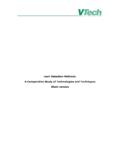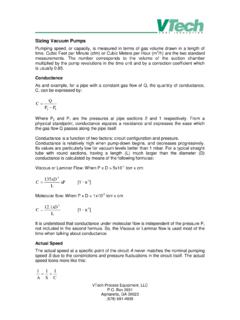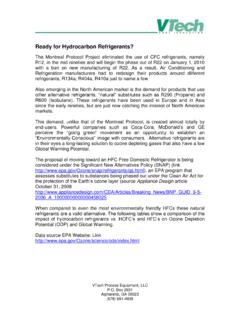Transcription of Background: Tracer Gas Leak Detection - …
1 background : Tracer Gas Leak Detection The term Tracer gas leak testing describes a group of test methods intended to detect and measure the flow of a Tracer gas through a leak. Examples of Tracer gases include halogen (refrigerants), helium and hydrogen 5%/nitrogen 95% mix. These techniques differ depending on the Tracer gas used and the equipment design. The most commonly used Tracer gas, other than halogen refrigerants, is helium. Helium has been used successfully as a Tracer gas for long time due to its physical properties. It is neither toxic nor flammable, is inert and does not react with other compounds.
2 Helium has low viscosity and relative molecular mass, so it easily passes through porosities. In the same environmental conditions, it flows through orifices times faster than air. Since its concentration in air is low (5 ppm), it is easy to detect an increment of helium concentration. However, there are some shortcomings. Helium disperses slowly into the atmosphere, so, in case of big leaks, its high concentration will contaminate the area for a long time, even hours. Also, Helium is relatively expensive when compared to other industrial gases, so wasting it in the case of a big leak is very costly.
3 A helium mass- spectrometer is the instrument best suited for detecting it ( mass 4). It is important to remember that background concentration in air is a limiting factor for any Tracer gas detector. There are two ways to carry out leak testing with helium Tracer gas: external Detection of Tracer gas escaping from leaks of a filled unit (inside-out method), and internal Detection of Tracer gas entering from leaks (outside-in method). For each of these two methods there are two realization techniques. The inside-out methods can be executed with atmospheric sniffing or with vacuum chamber Detection , while the outside-in method is generally implemented by putting the unit to be tested in an enclosed space containing the Tracer gas or, very rarely, spraying the Tracer gas on the unit surface.
4 For our purposes, we will focus on the two automatic methods of helium sniffing, as described in the sections to follow. Vacuum Chamber Inside-out Leak Testing Overview Vacuum chamber inside-out leak testing is suitable for detecting very small leaks. Its sensitivity, depending on Tracer gas and test time, can reach 10-10. mbar l/s, even if for a practical application in the refrigeration industry the limit is 10-7 mbar l/s. This method has some advantages. This technique is fully automatic, so it depends very little on an operator. The equipment is composed of one or more vacuum chambers, large enough to house the unit to be tested.
5 The chamber is connected to a vacuum VTech Process Equipment, LLC. Box 2931. Alpharetta, GA 30023. (678) 691-4935. pumping group equipped with the Tracer gas detector, for chamber evacuation and gas Detection . A second vacuum group is required to evacuate the unit under test before filling it with gas. A Tracer gas-filling device completes the testing apparatus. The unit to be tested is put into the vacuum chamber and connected to service hoses. Then the vacuum chamber and the unit are evacuated. During chamber evacuation, the part is pressurized with the Tracer gas and, after a stabilization time, the mass spectrometer is linked to the vacuum line in order to detect the Tracer gas flow drawn in by the pumping group through a leak and is detected.
6 It is a go-no go test, so finding the leak location requires other techniques. Application In "inside-out" techniques, known also as global hard-vacuum test , the component is placed inside an air-tight chamber provided with service hoses and a vacuum pumping group with a mass spectrometer. The unit is connected to the service hoses, the chamber is closed, the part is evacuated and then pressurized with helium. The chamber is subsequently evacuated and once a suitable vacuum level is reached, the inlet valve of the leak detector is opened.
7 The leak detector begins to analyze to the residual gas molecules present in the chamber. Any helium molecules that escape from the component are conveyed and measured by the leak detector. At the end of the cycle, the vacuum chamber is vented. The leak detector gives the total measurement of the leak. Referring to the complexity of the test and the desired degree of automation, different test systems may be realized from the simplest to more elaborate. As an example, a two chamber machine can be realized so that in one chamber the test cycle is in progress while in the other chamber a part is unloaded and reloaded.
8 In many industrial applications, in order for the test chamber to reach the vacuum level in acceptable times, an auxiliary pumping group is needed. The dimensioning of the pumping group depends on different parameters, such as the body of the expected leaks, the dimensions of the parts to be tested and the desired cycle time. In design and realization of the vacuum chamber, particular care must be taken to avoid helium contamination. In fact, if some helium remains on the chamber's inner surface or in some internal components, the background helium level will be high and the sensitivity will consequently be reduced.
9 If the test unit has a large leak a lot of helium would leak out of the test unit and into the vacuum chamber, the mass spectrometer and the vacuum pumping station. One solution for this an initial nitrogen filling, before each test, besides the mechanical stress and leakage test, allows purging the circuit to be tested, lowering its humidity. At the end of cycle, the part may be filled again with nitrogen, even at a low pressure, to purge its internal circuit from the helium residuals before vacuum chamber venting. VTech Process Equipment, LLC.
10 Box 2931. Alpharetta, GA 30023. (678) 691-4935. Outside-in Leak Testing Overview Outside-in Leak testing is capable of detecting small leaks. The sensitivity, depending to Tracer gas and test time, can reach x 10-6 mbar l/s. This technique is fully automatic, so it is not operator dependent. In this testing technique, the unit to be tested is put into an enclosure containing the helium Tracer gas. The part is connected to a vacuum group and evacuated. A mass spectrometer is placed in the vacuum line in order to detect the Tracer gas flow pulled in by the pumping group through a leak.




